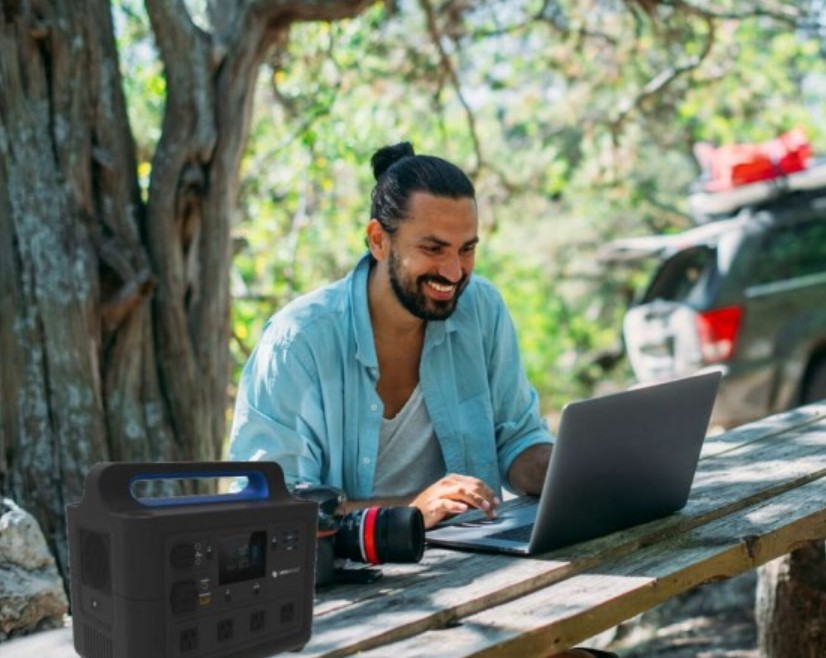NRGVault PV1500 portable Power Station – pretty perfect (off-grid review)

The NRGVault PV1500 power station is best described as a portable battery power bank that can provide AC and DC power on the go. It is perfect for campers, tradies/worksites, and as an emergency power backup.
The NRGVault PV1500 is our first portable power station review, so please bear with us as we explore the delights of working off-grid. The smaller PV500 joins it – more of the same but with less capacity.
Stop and breathe!
We started reviewing the NRGVault PV1500 power station, but we needed benchmarks or a guide to know if it was good or not so good. So began the laborious process of extensive research, talking to experts, consulting our user panel, and fact-checking with Chris Lau, Laser (NRGVault), Managing Director, to ensure we got the brand agnostic guide right.
So, before we review the PV1500, we must explain what portable power stations do. We strongly suggest you read CyberShack’s new Portable Power Stations – power on the go (Guide).
We discovered that there are few accepted ‘standards’, lots of marketing hype to disguise inadequacies, rampant use of low-cost, short-life batteries in many generic brands, and a realisation that this industry segment is growing exponentially. If you have not had a portable power station before, the chances are that you can incorporate one into your life.
Australian Review: NRGVault PV1500 Power Station
| Website | Home Page PV1500 page and Manual PV500 page and Manual |
| Price | PV1500 $1799.95 PV500 $599.95 |
| Warranty | Three years ACL Warranty |
| From | NRGVault online or Harvey Norman and Joyce Mayne |
| Made in | China |
| Company | You may not know the name Laser Co, but chances are that if you have shopped for electronic or smart accessories at Harvey Norman, JB Hi-Fi, Good Guys, Bing Lee, Big W, Kmart and more, you have bought Laser or its retailers’ house-branded products. It is not just LASER (website) but also its CONNECT Smart Home range, Disney, Tech4Pets, Navig8r, Gtek range and now NRGVault. |
| More | Laser Co – 35 years young and ready for the next challenge |
We use Fail (below expectations), Pass (meets expectations) and Exceed (surpasses expectations or is the class leader) against many of the items below. We occasionally give a Pass(able) rating that is not as good as it should be and a Pass ‘+’ rating to show it is good but does not quite make it to Exceed. You can click on most images for an enlargement.

First Impression – a tough assignment
The good news is that now that we have a guide and benchmarks, the NRGVault PV1500 meets or exceeds the Guide benchmarks.
But let’s start with the naming – PV1500. Most brands advertise the Inverter capacity (how many Amp hours it can provide) because it is a lot higher figure than another important measurement – how long it can sustain that Amperage (called Watt Hours or Wh). In this case, it is 1228Wh.
There is a second vital figure too called peak power. Many electrical devices draw a far higher amperage at startup. The PV1500 is excellent as it can take a 2000W startup surge.
In the guide, we found dollars per watt hour to be a good start for comparison. In this case, it is $1.47 per Wh, which, Prima facie, is excellent value if all other specs stack up.
It is a small Esky-sized, Black ABS plastic with sky-blue highlights, 350 x 220 x 313mm x 15.8kg, with a top carry handle and four rubber feet. It has no IP rating, so it is for indoor and undercover use.
Batteries – Lithium Iron Phosphate (LiFePO4) – Exceed
LiFePO4 are the safest batteries to use. You can read more in our guide but suffice it to say that as the best, they are also the most expensive.
The PV1500 is rated for 2500 charge cycles and still holds at least 80% of the charge (about 1000W). NRGVault says that they see as high as 5000 recharge cycles in testing this new model.
That raises another benchmark – cost per charge cycle (excluding electricity). At 2500 cycles, it is 70 cents. If its tests are accurate, it could be as low as 35 cents, making it one of the most cost-effective to own.
These batteries also retain charge longer – in tests, they still have 90% of the charge after six months. If you are not using the unit for some time, charge it to 80% and check and top up every few months.
Power delivery – 1500/2000W – Exceed
It has a 1500W pure sine wave inverter with a peak power of 2000W for 1 second. This is enough for a small fridge compressor or power tool to power up before stabilising below 1500W.
Wh – 1228 – Exceed
It uses 64 x 32700 size, 3.2V/6A/1228Wh cells – you typically get 5-10% less efficiency. We ran a 100W incandescent bulb for over 12 hours (1200Wh), and it was empty. If you used a 5W LED light, you would get 245 hours.
Charge Time – 1.5 hours – Exceed
We could not test solar ($550 portable panels, 300W foldable option) or car battery ($29.95 option 15-30V/7A/300W car charger cable), but the fittings are the same as many other brands.
Car charge times depend on the V/A/W utility socket, typically ranging from 10-15 hours.
Like most other brands, the AC output ports cannot be used while charging. You can use DC output ports (pass-through).

Output sockets – Plenty – Exceed
- Four AC three-pin sockets that share 1500W (or a 1-second peak load to 2000W).
- One 12-13.6V/8A/108W car utility socket
- Two DC 12-13.6V 5221 plugs sharing 108.8W
- Four USB-A sharing 18W.
- USB-C (one in use) PD up to 20V/5A/100W for laptops
- USB-C 2 (two in use) QC 3.0 5V/3A/15W, 9V/2A/18W, 12V/1.5A/18W
The caveat is that you have 1500W to share across all ports.
LCD readout – Informative – Exceed
It accurately reports on input and output Watt and time remaining


Battery Management System – All essential – Pass+
Under/Over Voltage, Over Current, Short Circuit, Overcharging Voltage, Over Temperature, and Overload Protection.
Noise – Mostly quiet – Pass+
For most of the test, it was <30db, but when the fan cut in, it was up to 50dB.
Warranty – 3 years – Exceed
It is a class-leading, Australian Consumer Law-compliant warranty. You can claim warranty from your retailer or Laser Direct. Freight is covered both ways in the event of a warranty claim.
CyberShack’s view – NRGVault PV1500 Power Station is almost perfect
When writing our guide, we looked for brand-agnostic features. The NRGVault PV1500 meets or exceeds those parameters. Even better, Laser/NRGVault provides complete, unambiguous specifications and does not get caught up in the marketing hype of many other brands. You can be sure that it does what it says.
With the caveat that we have just started to review this device class and have not seen others yet, we feel confident that this is a good buy if you need a 1500W pure sine wave inverter and up to 1228 Wh.
If you need something smaller, the PV500 has a 500W pure sine waver inverter with 600W Peak power and 288Wh use. It is only 5kg.
Rating Explanation
- Features: 95 – It has everything you need. It does not have an App, Qi charge or lots of pretty fripperies.
- Value: 95 – It seems excellent value on a cost per Wh and ownership costs per recharge cycle. Laser/NRGVault has always been about value without sacrificing quality.
- Performance: 95 – it meets or exceeds every guide parameter and delivers a solid 1200+Wh.
- Ease of Use: 90 – Charge and play. Good readout and fast recharging. I think all portable power station makers should do more to educate buyers about their product’s capacity. According to Harvey Norman, the biggest issue is that people don’t know their power needs and tend to under-specify, leading to disappointment.
- Design: 90 – no frills, utilitarian.






